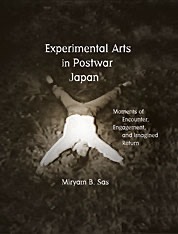News and Opinion
Experimental Arts in Postwar Japan
 Arguably the period of current greatest interest in Japanese film studies is the 1960s. Many scholars, young and old, are working on the period, especially if you expand it to include the late 1950s and the early 1970s. It was of course the time of the first "modernists" such as Masumura Yasuzo and Nakahira Ko; the beginnings of experimental cinema; the Japanese New Wave of Oshima, Imamura, Yoshida, et al.; a political pink cinema; the breakdown of the studio system; the rise of a new documentary; and the flourishing of independent film. An exciting period with much to research.
Arguably the period of current greatest interest in Japanese film studies is the 1960s. Many scholars, young and old, are working on the period, especially if you expand it to include the late 1950s and the early 1970s. It was of course the time of the first "modernists" such as Masumura Yasuzo and Nakahira Ko; the beginnings of experimental cinema; the Japanese New Wave of Oshima, Imamura, Yoshida, et al.; a political pink cinema; the breakdown of the studio system; the rise of a new documentary; and the flourishing of independent film. An exciting period with much to research.
David Desser's Eros Plus Massacre - already over 20 years old! - is still a very useful introduction to the period. But it is testimony to the richness of the time that there is so much that Desser does not deal with. Much attention has been given to the theoretical context in these years (Yuriko Furuhata's dissertation, etc.) and to more marginal genres like documentary (Markus Nornes's work on Ogawa), pink film (Jasper Sharp's book and an upcoming anthology), and experimental cinema (including recent ATG retrospectives and attention to Matsumoto Toshio).
War, Nationalism, and Forgetting the Postwar in Yamato
After moving my office and then moving myself to Japan for the summer, I can finally update the blog for the first time in a couple of weeks.
My announcement today is that Japan Focus has published another article of mine (previous ones were on recent fantasy war films and Clint Eastwood's Iwo Jima films). This is a much shorter version of a long piece that I wrote for the forthcoming Distorted Lens anthology, which is based on a conference at Stanford in December 2008 and which is being edited by Chiho Sawada and Michael Berry.
The longer version looks at a number of recent films made about kamikaze missions during WWII and compares them to earlier examples from the 1950s to the 1970s. Most discussions of Japanese war films have considered them in terms of how they warp, gloss over, or forget the problems or traumas of the war, but I analyze them in terms of how they work to forget the problematic history of postwar Japan. My main text is Sato Jun'ya's Yamato (Otokotachi no Yamato, 2005). I particular argue that the film's use of what I call vicarious trauma in depicting the demise of the young recruits on the Battleship Yamato functions to erase postwar trauma, an operation that I consider to be the other side of the same coin to the nostalgic depictions of 1950s and 1960s Japan in films such as Yamazaki Takashi's Always--Sunset on Third Street (Always--Sanchome no yuhi).

